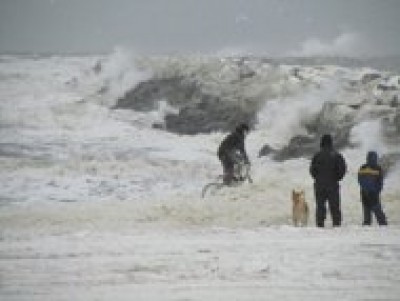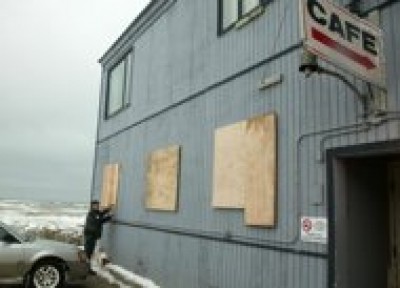January 7th, 2011 Alaska Town Tries To Dig Out From Huge Snow Dump
By RACHEL D’ORO | AP

In this Saturday, Jan. 7, 2012 photo provided by the Alaska Division of Homeland …
…ANCHORAGE, Alaska (AP) — Dozens of National Guard troops have arrived to help an Alaska fishing town dig out from massive snows that have collapsed roofs, trapped some people in homes, and triggered avalanches.
Cordova is used to snow, but not like this season’s blanketing.
The Guard reported more than 18 feet of snow has fallen in the past weeks, although the National Weather Service did not immediately have a measurement.
“There’s nowhere to go with the snow because it’s piled up so high,” said Wendy Rainney, who owns the Orca Adventure Lodge. A storage building for the lodge — which offers fishing trips, hiking, kayaking and glacier tours — partially collapsed under the weight of the snow, she said.
“This is more quantity than can be handled.”
Officials said at least three buildings have collapsed or partially collapsed and six homes are deemed severely stressed by heavy wet snow.
The city has set up a shelter at a local recreation center, but said people leaving homes in avalanche-risky areas have been staying with other residents. Cordova spokesman Allen Marquette said the town also was ready to set up a pet shelter if necessary.
The town issued a disaster proclamation last week after three weeks of relentless snow overwhelmed local crews working around the clock and filled snow dump sites.
“We had no alternative but to declare an emergency,” Cordova Mayor Jim Kallander said. “It became a life-safety issue.”
Responders said Sunday that rain fell overnight, making for a slippery, treacherous mess in the Prince William Sound community of 2,000 year-round residents. The region has been pummeled by snow, but Cordova is of particular concern because there is no road access to the town, only boat and plane passage, said Maj. Gen. Thomas Katkus, adjutant general of the Alaska National Guard.
There have been no reported injuries, but bad weather has prevented the Guard from flying to the town, 150 miles southeast of Anchorage.
More than 70 Guard members arrived in Cordova via state ferry Sunday. About 50 of them will help clear roofs, roads, boats. The rest will provide other assistance. Three state emergency workers were already in town to help with emergency response planning. The state also is working on bringing in more heavy equipment to Cordova.
Katkus said Guard members will be on hand for up to two weeks. “This is an ongoing operation,” he told reporters Sunday.
An avalanche brought snow and debris down on a section of the Copper River Highway, the 12-mile link from the town to the local airport. State transportation officials said a secondary road was opened to two-lane traffic while crews cleared the highway Sunday.
Another storm that started Saturday also brought rain, which soaked into the snow, weighing it down.
Classes will begin later than usual Monday, but officials said students should go only if parents are comfortable with them venturing out.
Some roads have been cleared, but officials say residents also are being creative, traveling on foot and by skis and snowshoes.
The National Weather Service said the snow depth at the airport measured 59 inches before the rain fell, weighing the level down to 47 inches. Monday is supposed to be clear before another system moves in Tuesday, bringing more snow and rain, as well as winds as strong as 40 mph.
“This break in the weather is very critical and very fortunate,” meteorologist Don Moore said.
Momma’s Source: yahoo news
Share This


